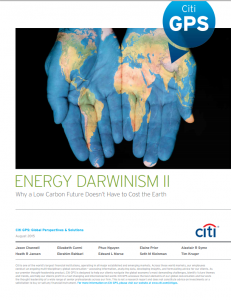Full Title: Energy Darwinism II: Why a Low Carbon Future Doesn’t Have to Cost the Earth
Author(s): Jason Channell, Elizabeth Curmi, Phuc Nguyen, Elaine Prior, Alastair R Syme, Heath R Jansen, Ebrahim Rahbari, Edward L Morse, Seth M Kleinman, and Tim Kruger
Publisher(s): Citi GPS: Global Perspectives and Solutions
Publication Date: August 1, 2015
Full Text: Download Resource
Description (excerpt):
Citi forecasts that the sums of money to be spent on energy (both capital expenditure and fuel) over the next quarter century will be unimaginably large, at around $200 trillion. The energy industry is faced with choices, and in this report, we outline two scenarios: 1) a business as usual or ‘Inaction’ on climate change scenario, and 2) a different energy mix that offers a lower carbon alternative. We find that out to 2040 the levels of spend are remarkably similar; indeed the ‘Action’ scenario actually results in an undiscounted saving of $1.8 trillion over the period, as while we spend more on renewables and energy efficiency in the early years, the savings in fuel costs in later years offset earlier investment. If the scientists are correct, the potential liabilities of not acting are equally vast. The cumulative ‘lost’ GDP from the impacts of climate change could be significant, with a central case of 0.7%-2.5% of GDP to 2060, equating to $44 trillion on an undiscounted basis. If we derive a risk-adjusted return on the extra capital investment in following a low carbon path, and compare it to the avoided costs of climate change, we see returns at the low point of between 1% and 4%, rising to between 3% and 10% in later years. So can we afford to act? Examining the extra spend required in our ‘Action’ scenario in the context of global GDP, we find that on an annual basis we only have to spend around 0.1% of GDP more on energy, and that on a cumulative basis at its worst point, the extra investment only amounts to around 1% of global GDP. Moreover, against a backdrop of secular stagnation, that extra investment may actually help to boost growth.
